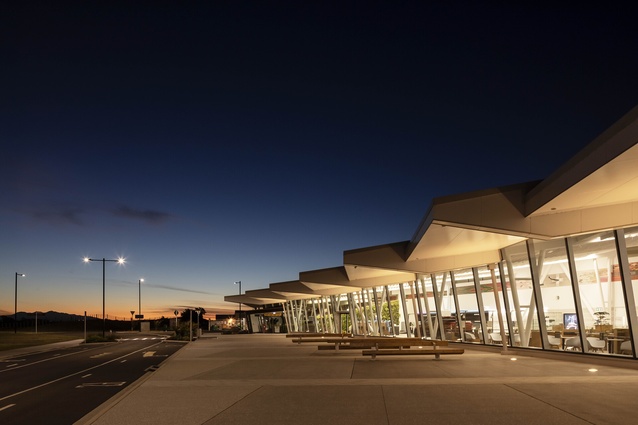Te Hono New Plymouth Airport a finalist for UNESCO prize
The new airport terminal, designed by Beca Architects, has been selected as a finalist for the Prix Versailles, which recognises works that honour cultural heritage. Built on land confiscated from Mana Whenua in the 1960s, Te Hono was constructed decades later with input from the local Puketapu Hāpu.
The acknowledgement of the land’s history has seen Te Hono nominated for the Prix Versailles, established by UNESCO in 2015 to recognise architecture which promotes an improved relationship between economy and culture.
Te Hono is one of six finalists in the Prix Versailles airport category for 2021, with the winners to be announced at UNESCO’s Parisian headquarters in late November. The project – a small, regional airport – has been shortlisted alongside much larger hubs, including New York’s La Guardia and Berlin’s Brandenburg Airport.
“This was not just a collaboration, it was a partnership,” says project architect Campbell Craig, an Associate in Beca’s Design Practice. Referring to the Puketapu Hāpu, Craig says they “sat alongside each other, shoulder to shoulder, at the design table in numerous, full-day workshops throughout the concept and preliminary design stages … The experience at Te Hono provided a blueprint for working with tangata whenua. Moving forward, it’s an approach that will be embedded within all our projects”.
With six design narratives suggested, a two-day wānanga saw the story of Tamarau, who descended from the heavens to meet with Rongo-ue-roa, chosen as the principal theme by hapū member and cultural design lead Rangi Kipa. “This story aligns closely with the creation narrative of Te Ātiawa iwi,” says Kipa. “For the most part, we have been invisible in our own landscape for 160 years, so it’s amazing to have the chance to influence, and give life to, some of the things that make us who we are.”
This origin story would serve as the inspiration for the design of the terminal’s roofline, with hand-drawn designs a major part of the process. “The roof form developed from numerous sketches by the design team, highlighting the radial formation and fractal patterning of the feathers on a bird’s wing,” comments Campbell. “This was a deliberate attempt to contrast the strength of parallel design drivers, which Rangi explained have no meaning in Māori design.”
Along with the roofline, the spine of the building is orientated to reflect the main ancestral walking track in the area, from the mouth of the Waiongana river to the nearby Maunga Taranaki, which can be seen on a clear day from the terminal. “The airport gives visitors to our region a Taranaki-specific experience and is an opportunity to start to reaffirm our narratives, idioms, ethics and norms – the cultural edifices that support us,” says Kipa. As well as further incorporating the history of the region into the Te Hono, the design also serves as a straightforward connection from the parking lot through the departure area to the plane. Inside, the terminal is home to a 70-metre tututuku panel, also based on the story of Tamarau and Rongo-ue-roa.
Carrying on from Kipa, Campbell further elaborates on the role that manaakitanga, the Māori concept of hospitality, played in underpinning the airport’s practical elements. “It was important for Puketapu to welcome and take care of guests in a place that is in many ways the gateway to the region.” Representing Papa Rererangi i Pukutapu New Plymouth Airport, chief executive David Scott states that a “co-design process has resulted in a building not only cultural of significance, but one that works exceptionally from an operational perspective too. It demonstrates what can be achieved when we work together as true partners.”
Watch the video about the design of Te Hono here.










